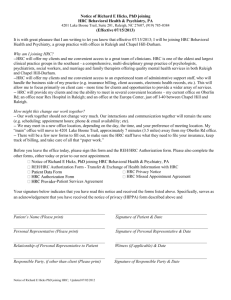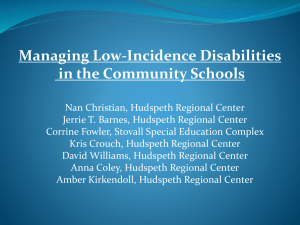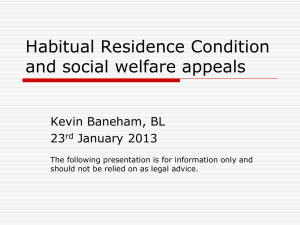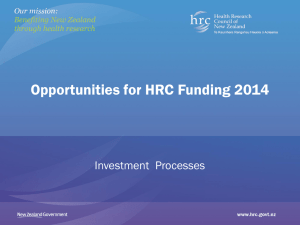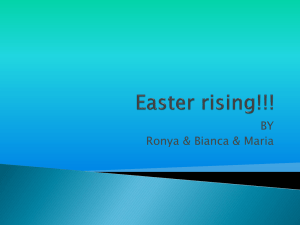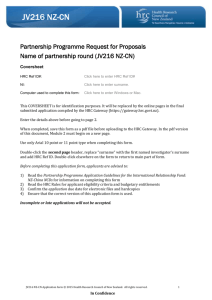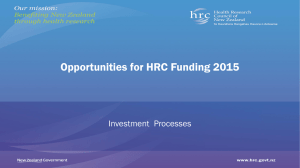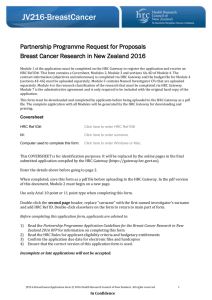Barriers to Social Welfare
advertisement
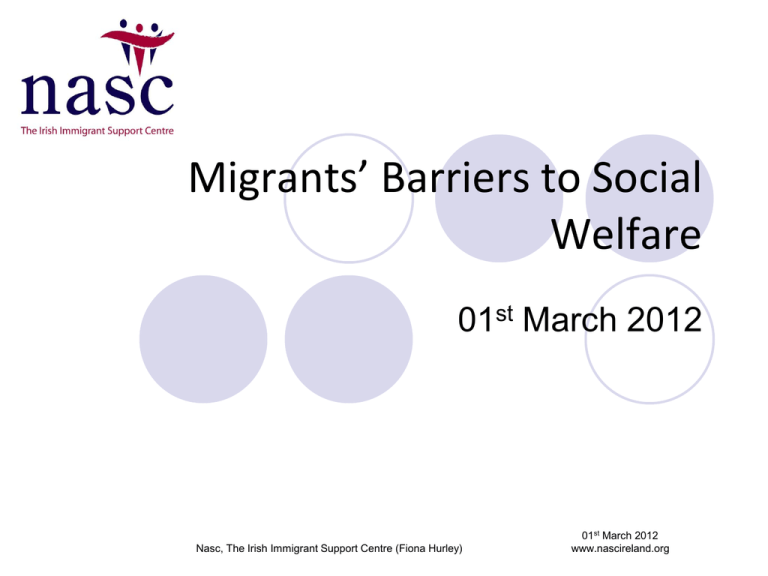
Migrants’ Barriers to Social Welfare 01st March 2012 Nasc, The Irish Immigrant Support Centre (Fiona Hurley) 01st March 2012 www.nascireland.org Nasc – The Irish Immigrant Support Centre Nasc – the Irish Immigrant Support Centre is an NGO that seeks to respond to the needs of immigrants, refugees and asylum seekers. Nasc is the Irish word for ‘link’ – We link migrants to their rights. Our vision: To contribute to an environment of social inclusion for all communities, based on the principles of of equality, social justice and human rights. Reuniting families Reconnecting Communities Reforming legislation ‘Person or Number?’ – Issues faced by Immigrants Accessing Social Protection Snapshot of 54 cases presenting to 6 NGOs nationally Report published by Crosscare, Doras Luimni and Nasc – the Irish Immigrant Support Centre Available for download from http://www.nascireland.org/ Barriers Identified in ‘Person or Number?’ Poor information provision and adversarial approaches Decisions based on speculation Processing delays Inappropriate, aggressive and racist language Misapplication of the HRC Domestic Violence Lack of understanding of Immigration status Failure to grant Exceptional Needs payments in situations of urgency Fear of refusal of citizenship Homelessness The Habitual Residence Condition Failure to apply the exemption from HRC determination to EEA workers Failure to look at the full facts of the case under the Swaddling criteria Temporary Absences from the State HRC simply stated as a reason for refusal without giving more specific reasoning Case Study: Toms Toms Toms is from Latvia and came to Ireland for the first time in 2005. After working for five months with a construction company he was made redundant, he then spent another nine months working and studying in Ireland before returning temporarily to Latvia. He returned to Ireland in 2007 and has been resident in Ireland since then. Toms had three different periods of employment in Ireland following his return – one for three months, one for four months and one for fourteen months. When his last job finished in 2010 he applied for Jobseekers Allowance and SWA - both applications were refused on HRC grounds even though as an EEA worker he was entitled to an SWA payment. At the time of writing Toms was homeless. High rate of decisions overturned on appeal YEAR No. Of HRC Appeals Decisions Appeals Upheld/Partially Upheld Appeals Disallowed 2011 4,146 747 3,399 2012 5,549 2,369 3,180 Parliamentary Questions: Minister for Social Protection (Deputy Joan Burton) Question 394 on the 21st February 2012 Person or Number? Habitual Residence Condition recommendations Drawing on data from the Social Welfare Appeals Office, it is recommended that the Department of Social Protection undertakes a detailed and published examination of allowed HRC appeals on a periodic basis. Specific approaches and deficiencies evident in the practice of departmental staff in allowed HRC appeals need to be collated in detail and addressed comprehensively at front line level on a regular basis. Annual targets for proper implementation of the HRC should be set, based on allowed and disallowed HRC appeal decisions from the Social Welfare Appeals Office. The departmental guidelines on the HRC exemption for EEA workers must be urgently revised, for they are currently misleading and inaccurate. The guidelines for temporary absence from the State must be significantly augmented and written for service user access. More detail as to specific required actions of service users must be provided. The absences currently allowed do not reflect the reality of immigrants’ lives. These guidelines should be reviewed in conjunction with immigrants and immigrant NGOs and circulated widely and advertised clearly. It is also recommended that the guidelines are translated into key foreign languages. The ‘temporary absence from the State’ guidelines must specifically clarify what temporary absences from the State do not affect the Habitual Residence Condition. The HRC1 Form should be revised to ensure that applicants are specifically invited to address each of the five factors that a deciding officer is obliged to consider. Case Study Domestic Violence: Laima Laima is from Lithuania. She has two children aged five and ten years old. She came to Ireland in 2007 to join her partner, who was working. Laima found a job for four months. Things were going well in the beginning but her partner started partying and drinking with his friends. Then abuse started: her partner was calling her names, humiliating her in front of other people and not giving her money for food & clothing. She separated from him in January 2009 and continued to look for some work. She applied for One Parent Family (OPF) Payment after they separated. Not long after, her partner broke the front door of where she was staying and threatened her. Laima went to an NGO for support. At that stage Laima’s apartment was in rent arrears and the ESB bill was unpaid. One day she came home and found that electricity was cut off. She had to move to a homeless women’s hostel with her two children. The CWO officer attached to the local homeless hostel met Laima and gave her a one-off SWA payment stating that she was not habitually resident in the State. Even though the officer was sympathetic to Laima’s case, she said she could not pay anything after that as per her superintendent’s direction. She was still getting Child Benefit and was paying rent for the homeless hostel out of her Child Benefit money. She was still looking for a job and doing different courses to improve her chances of employment. Her OPF claim was refused based on the fact that she was not considered habitually resident. Her Child Benefit was also cut in April 2010 as she was seen as not habitually resident. She could not afford to leave the homeless hostel until December 2010 when her Child Benefit was finally restored and back-dated. She had to stay in a homeless hostel for sixteen months with two children. In February 2011 she was finally granted her OPF after a long battle. The NGO in question worked with Laima intensively for one and a half years in order for her to get the supports she was always entitled to Case Study: Domestic Violence Emilia Emilia came to Ireland from Poland four years ago to join her husband who was working in Ireland. She had her first baby here and was a full-time mother. She wanted to find work and learn English but her husband did not like that idea and tried to stop her from doing that. Her husband was violent towards her and assaulted Emilia on many occasions. She had to call the Gardaí many times and she made a statement to the Gardaí on one occasion. Emilia eventually decided to leave her husband. Firstly she wanted to know if she would get help if she was on her own. She went to her local Social Welfare Office to see if she would get any support if she left her husband. She was told that she would not get any help because she had no work record in Ireland and so she went to a local NGO. Emilia believed that she and her daughter would become homeless if she left her husband so she has stayed living with him.

